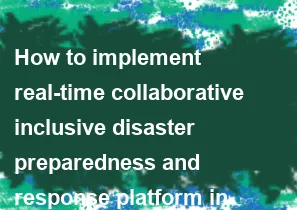How to implement real-time collaborative inclusive disaster preparedness and response platform in AngularJS

Implementing a real-time collaborative inclusive disaster preparedness and response platform in AngularJS involves several steps. Here's a high-level overview of how you can approach it:
Planning and Requirements Gathering:
- Define the scope of the platform.
- Identify the features and functionalities required for disaster preparedness and response.
- Gather requirements from potential users and stakeholders, including disaster management professionals, volunteers, and affected communities.
Designing the Architecture:
- Determine the architecture of your AngularJS application.
- Choose appropriate technologies for real-time collaboration, such as WebSockets or WebRTC.
- Decide on the backend technology stack for managing data and facilitating real-time communication.
Setting Up the Development Environment:
- Install Node.js and npm (Node Package Manager) for managing dependencies.
- Set up a version control system such as Git for collaboration.
- Install AngularJS using npm or include it via CDN.
Building the User Interface:
- Design the user interface for the platform, focusing on simplicity and accessibility.
- Use AngularJS directives, controllers, and services to implement the UI components.
- Implement responsive design to ensure usability on various devices.
Implementing Real-Time Collaboration:
- Integrate a real-time communication library such as Socket.IO or Firebase to enable collaboration features.
- Implement features like live chat, real-time updates on disaster situations, and collaborative planning tools.
Integrating Mapping and Geolocation Services:
- Utilize mapping APIs like Google Maps or Mapbox to provide location-based information.
- Implement features for visualizing disaster-affected areas, evacuation routes, and resource distribution centers.
Incorporating Accessibility Features:
- Ensure that the platform is accessible to users with disabilities by following accessibility best practices.
- Implement features like keyboard navigation, screen reader support, and high contrast mode.
Testing and Quality Assurance:
- Write unit tests using frameworks like Jasmine or Karma to ensure the reliability of your code.
- Perform integration testing to verify that different components of the platform work together smoothly.
- Conduct usability testing with potential users to gather feedback and make improvements.
Deployment and Maintenance:
- Deploy the platform to a hosting provider such as AWS, Azure, or Heroku.
- Set up continuous integration and continuous deployment (CI/CD) pipelines to automate the deployment process.
- Regularly update the platform with new features and security patches based on user feedback and changing requirements.
Community Engagement and Training:
- Provide training and support to users, including disaster management professionals, volunteers, and affected communities.
- Encourage community participation and feedback to improve the platform over time.
By following these steps, you can implement a real-time collaborative inclusive disaster preparedness and response platform using AngularJS. Remember to iterate on the design and functionality based on user feedback and changing needs in disaster management.
-
Popular Post
- How to implement multi-language support in an Express.js application
- How to handle and optimize for changes in mobile search behavior
- How to optimize for Google's About This Result feature for local businesses
- How to configure Laravel Telescope for monitoring and profiling API requests
- How to use Vue.js with a UI framework (e.g., Vuetify, Element UI)
- How to handle CORS in a Node.js application
- How to create a command-line tool using the Commander.js library in Node.js
- How to implement code splitting in a React.js application
- How to use the AWS SDK for Node.js to interact with various AWS services
- How to use the Node.js Stream API for efficient data processing
- How to implement a cookie parser middleware in Node.js
- How to implement WebSockets for real-time communication in React
-
Latest Post
- How to implement serverless authentication with Firebase Authentication in a Koa application
- How to use the Node.js axios library for making HTTP requests with interceptors for FormData and file uploads in Koa
- How to implement a custom middleware for handling multipart form data in a Koa application
- How to use the Node.js axios library for making HTTP requests with interceptors for automatic redirection handling in Koa
- How to implement serverless authentication with AWS Cognito in a Koa application
- How to use the Node.js axios library for making HTTP requests with interceptors for automatic retries in Koa
- How to implement a custom WebSocket authentication strategy in a Koa application
- How to use the Node.js axios library for making HTTP requests with interceptors for automatic cookie handling in Koa
- How to implement serverless authentication with Auth0 in a Koa application
- How to use the Node.js axios library for making HTTP requests with interceptors for automatic JSON parsing in Koa
- How to implement a custom rate-limiting middleware with Redis in a Koa application
- How to use the Node.js axios library for making HTTP requests with interceptors for retries and timeouts in Nest.js